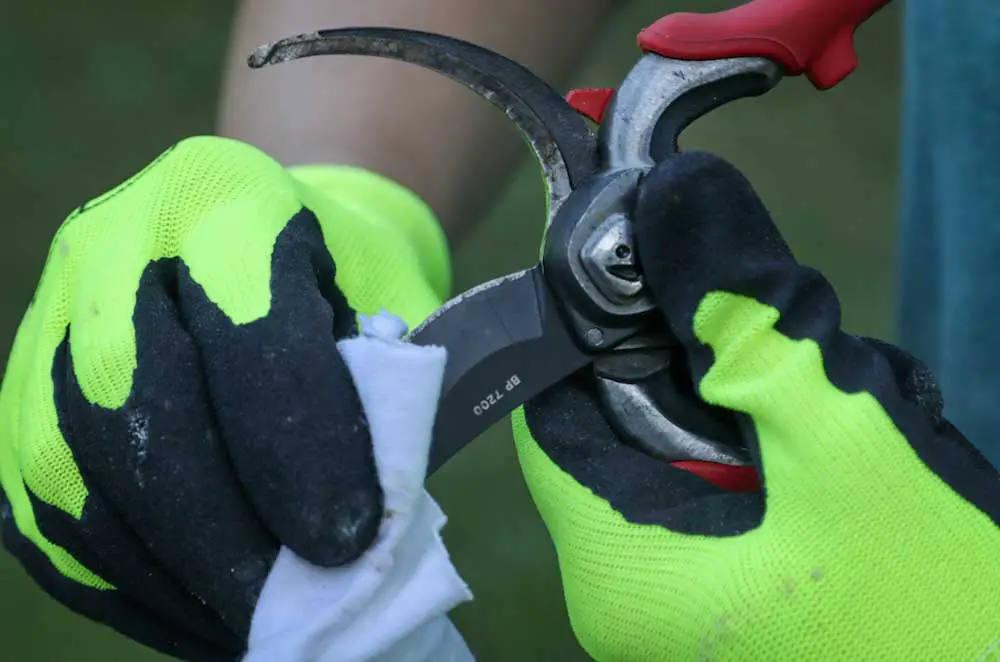
We may receive commissions from purchases made through links in this post, at no additional cost to you.
I’m always looking for ways to optimize taking care of my fruit trees. I’m not the most organized person, but if I can get into habits that help me stay on top of fruit-tree care, it’s going to make my life a lot easier (and my trees healthier). Learning how to properly clean and maintain my pruning equipment – and doing it immediately after pruning – is one of those game-changing habits.
So how do you sanitize and store tools such as pruning shears, saws, and loppers? What should you use? Are there any products or practices to avoid? After lots of trial and error (and research!) here is my recommendation:
To properly maintain pruning tools, first remove dirt, sap, and other debris with a damp cloth or stiff brush. Then wipe down the tools with a clean cloth soaked in 70% isopropyl alcohol to sanitize, and allow to dry. Avoid corrosive disinfectants such as bleach or TSP, which can damage tools.
There are many ways to clean and protect your pruning equipment, but some are better than others. I prefer to stick with methods that are inexpensive, readily available, and fast. Before we look at the different cleaning and sanitizing options, let’s look at why disinfecting tools is important.
Do pruning tools need to be sterilized?
Pruning tools should be sterilized after use to prevent the spread of certain disease pathogens from plant to plant. There is actually some debate about how necessary sterilization is for preventing disease transmission, but the consensus is that disinfecting pruning tools is the proper practice.
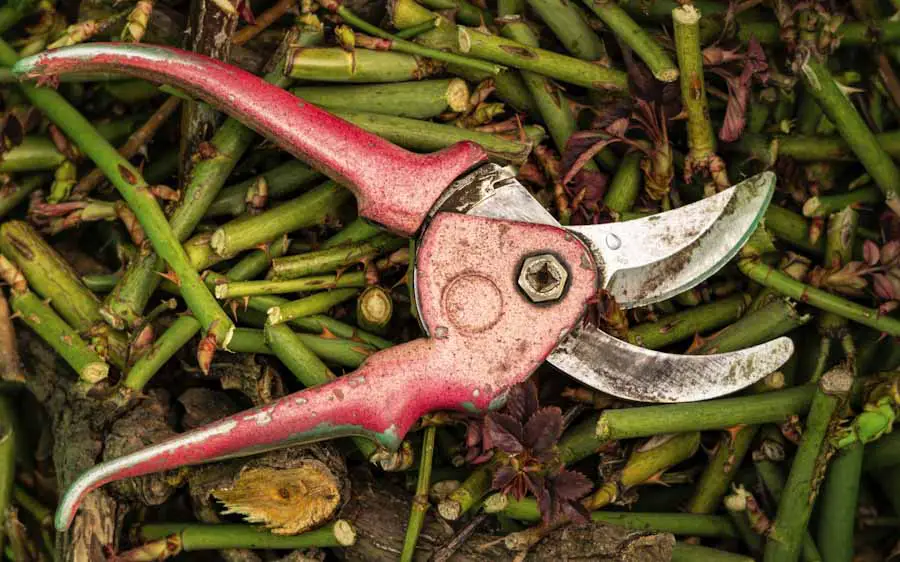
Some plant diseases are soil- or airborne (such as many bacterial and fungal diseases) and are far more likely to spread by your hands, clothing, and plant matter than pruning tools. This is why a key part of disease prevention is cleaning up debris around the plant, weeding, and pruning away diseased growth.
Related: A Simple Guide to Pruning Peach Trees for Maximum Harvest
But other diseases, particularly those that invade the vascular system of the plant (such as perennial canker, fire blight, bacterial spot, and viruses), are much more likely to spread through contaminated pruning tools.
Ideally, you would wipe or dip your tools in between cuts to prevent anything from spreading to another part of the same plant. (I, for one, find this to be cumbersome and not very practical when I’m pruning my fruit trees.) But, at minimum, always clean and disinfect pruning tools before moving on to the next tree or plant.
However, if I know the tree I’m pruning has some sort of disease, or did in the past, I will take more care. Wiping down the pruning shears or loppers between cuts is worth it to keep my fruit trees healthy.
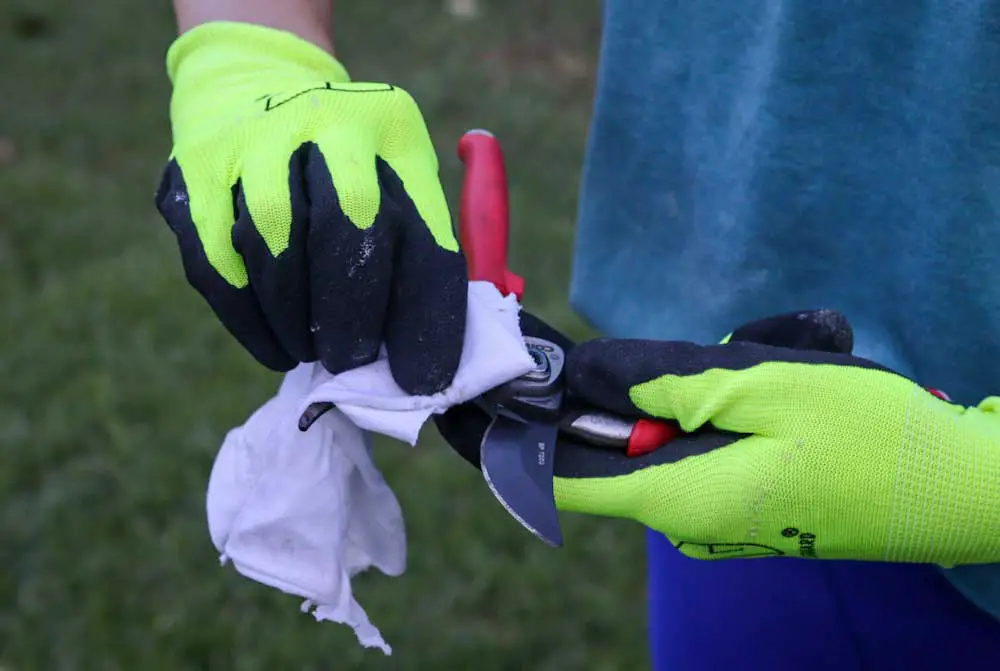
Research has also been done into the effectiveness of various kinds of disinfectants on garden tools. Let’s look at the most commonly used disinfectants, and the advantages and disadvantages of each.
Recommended Pruning Tool Disinfectants
Alcohol
In my experience, alcohol – isopropyl alcohol or ethylene (methylated spirits) – is the best option for disinfecting pruning tools. It’s inexpensive, easy to use, and very effective at killing plant pathogens. You can even use an alcohol-based hand sanitizer, as long as it dries fully before making another cut.
There’s no need to soak the tools in alcohol in order to disinfect. Wiping with an alcohol-soaked cloth, or spraying, wiping, and spraying again is enough for sanitization. You also don’t have to dilute it – you can use 70% isopropyl alcohol (often sold as “rubbing alcohol”) right out of the bottle.
Alcohol products are flammable, so take care to keep them away from heat sources or open flames.
- Pros: Inexpensive, convenient, effective as a disinfectant, no need to soak.
- Cons: None.
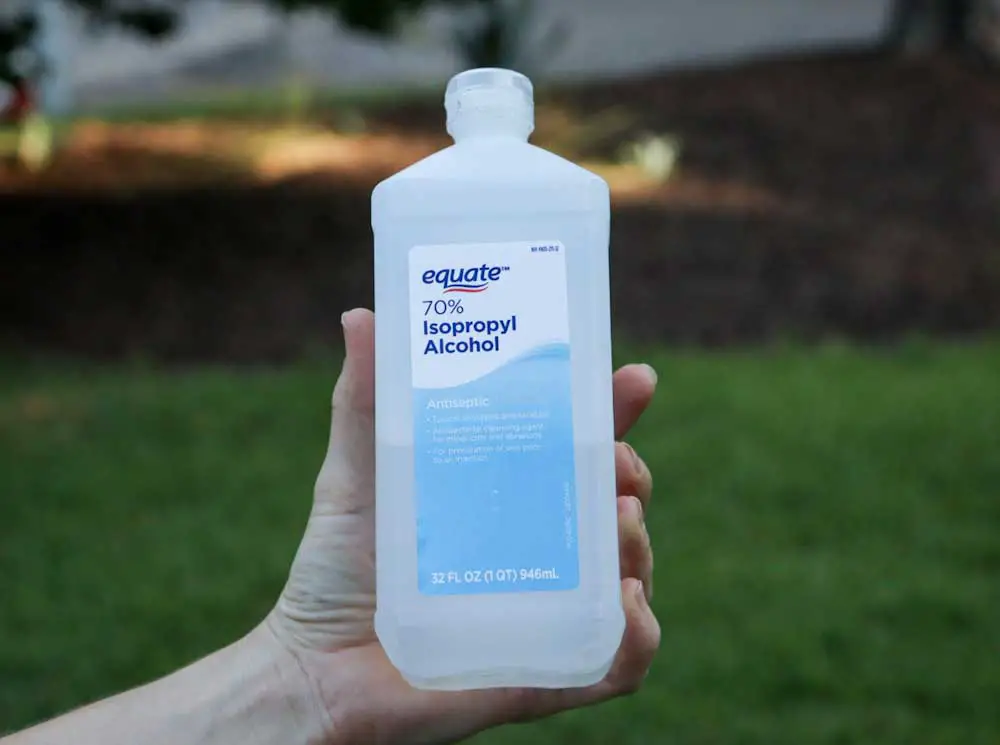
Household Cleaners (Lysol, Pine Oil)
Easy-to-find household cleaners such as Lysol (or other disinfectants) and pine oil products can be used to clean and disinfect pruning tools. There is less research on how effective they are at killing plant pathogens than other cleaners, but they are recommended for sanitization.
Lysol is also safe to use on metal tools, and serves as a good disinfecting substitute for bleach. Lysol can be used at full strength (unless you have a concentrated form), or you can use disinfecting wipes.
Pine oil products should be diluted to 25% strength (check the label – the newer Pine-Sol formulation no longer contains actual pine oil, and may not be effective). Pine oil is less corrosive to metal than cleaners like TSP or bleach, but it may not be as good at disinfecting pruning tools.
- Pros: Inexpensive, convenient, effective.
- Cons: May be less effective than bleach or alcohol.
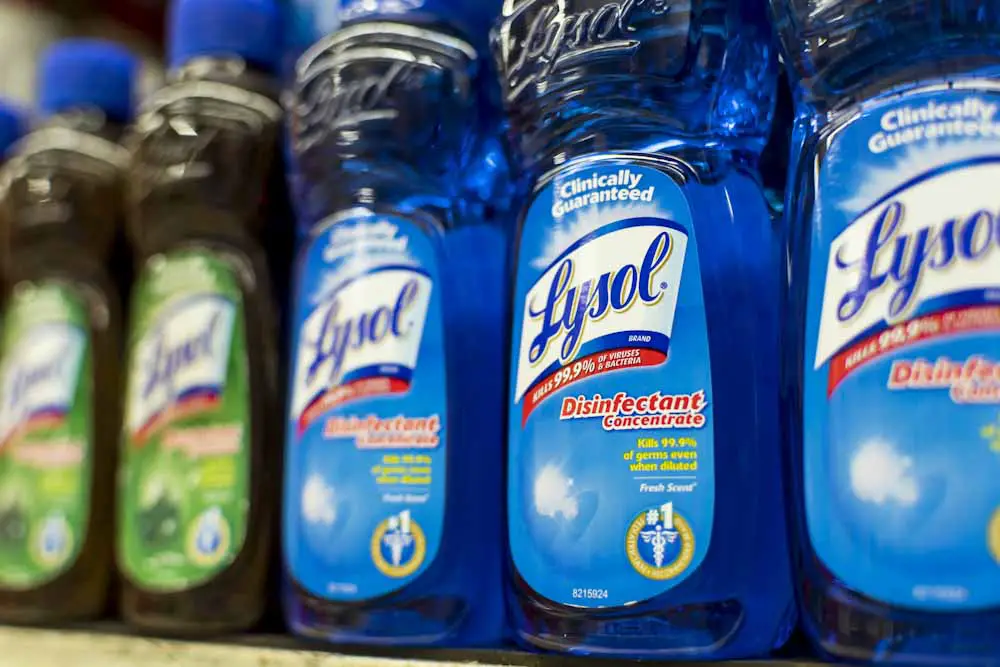
Commercial Garden Tool Disinfectants
Some disinfectants are specifically sold as garden-tool safe, such as Green-Shield, KleenGrow, ZeroTol, and Physan. These are labelled as safe to use on non-food surfaces, cutting tools, and directly on plants. Carefully read and follow the instructions on the package for proper usage.
- Pros: Effective, plant-safe.
- Cons: Often more expensive than other options.
NOT Recommended:
Bleach
Some sources (including many reputable ones) recommend using a 10% chlorine bleach solution to sanitize pruning tools. The problem is, bleach can be very corrosive to metal over time. Soaking the tools in a bleach solution (which is the recommended way to sanitize) can cause pitting in the metal, which will trap bacteria, dull the sharp blade, and shorten the life of the tools.
Bleach also loses efficacy after a couple of hours, so a new solution has to be mixed each time. Bleach can be phytotoxic (poisonous to plants), and it is not as effective against viruses as other options. It is, however, inexpensive and readily available.
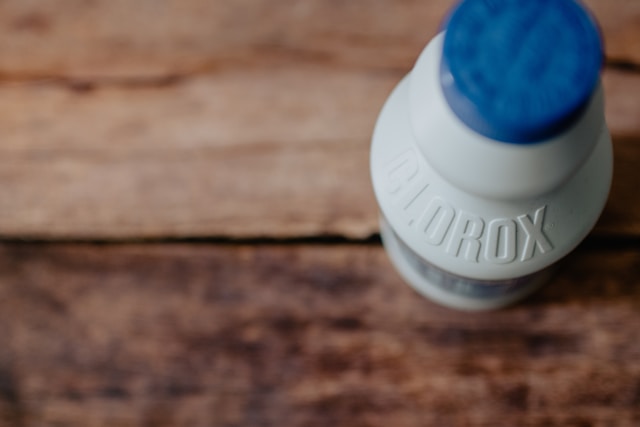
If you use bleach, dilute it to a solution that is 1 part bleach to 9 parts water. Soak the tools for about 30 minutes, then rinse and dry right away to prevent corroding the metal and to remove any bleach residue. Always wear rubber gloves and protective clothing when using bleach (it will ruin clothes), and use in a well-ventilated area.
You can use bleach wipes on garden tools, but it probably won’t be as effective as soaking at killing plant pathogens.
- Pros: Inexpensive, readily available, effective.
- Cons: Can damage tools, need to re-mix, not effective on viruses, irritant to skin and clothing.
Vinegar
Vinegar is commonly recommended for household cleaning, and for good reason. Its acetic acid helps it cut through buildup and grease, and it can kill or harm some bacteria. It is inexpensive and environmentally friendly. But is it safe and effective to use on pruning tools?
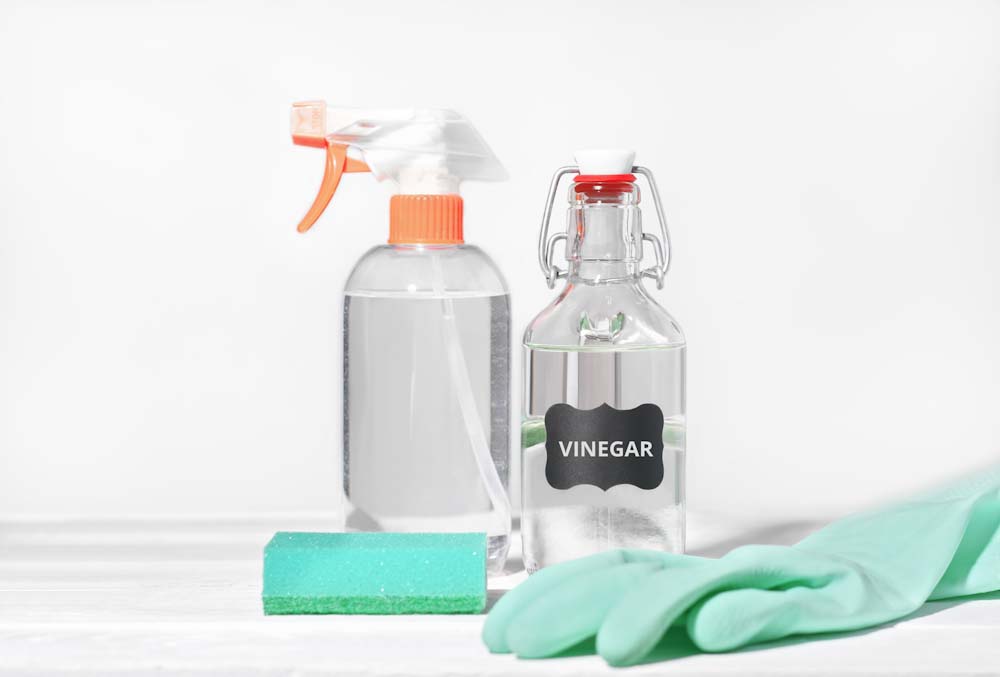
Safe? yes. Effective? not really. Vinegar can be useful for cleaning pruning tools and breaking down dried-on tree sap, but it is not strong enough to be considered a disinfectant (which means, effectively killing most bacteria). If your goal is to prevent the spread of disease from plant to plant, be sure to disinfect with something else.
- Pros: Inexpensive, convenient, cleans well.
- Cons: Doesn’t disinfect.
NOTE: Never use vinegar with bleach! The combination will produce chlorine gas, which can be deadly.
TSP (Trisodium Phosphate)
TSP is often sold as a heavy-duty outdoor cleaner. It is highly effective as a cleaner and sanitizer and is sometimes used in the wine industry to sterilize equipment. Although it’s safe when used correctly, it is controversial, however. The EPA has regulated TSP since 2011 because it contains phosphates, which can be harmful to water ecosystems. TSP detergents are even illegal to use in some states.
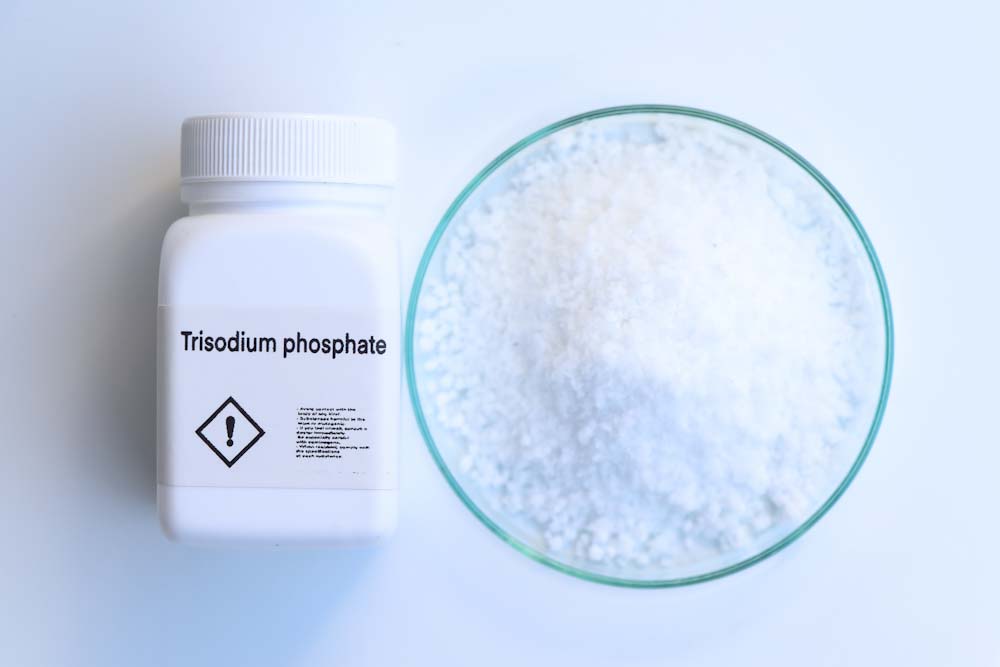
I would avoid using TSP unless some very heavy-duty tool cleaning was necessary. Like bleach, TSP can be corrosive to metal surfaces. Be sure to use TSP in a ventilated area and wear protective clothing, eye covering, and rubber gloves. Dilute it to a 10% solution, soak tools for 3-5 minutes, then rinse and dry.
- Pros: Inexpensive, highly effective for cleaning and sterilization.
- Cons: Corrosive, environmentally problematic, irritant to skin and eyes, illegal in some places.
How to Clean and Disinfect Pruning Tools
These are the simple steps I follow to sanitize pruning tools with 70% isopropyl alcohol in between plants. Get in the habit of wiping down your pruning shears, saws, and loppers after every use. If you store them clean and ready to use, it will be that much easier to grab what you need to take care of any pruning chores in the garden.
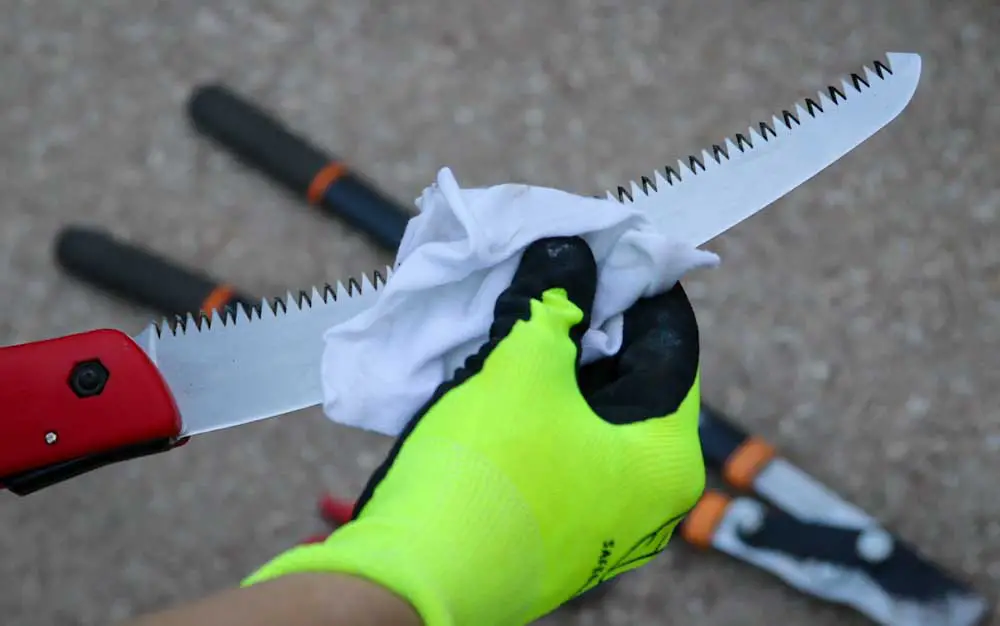
- Clean. Use a damp cloth or soak tools briefly in warm water to loosen up dirt, then wipe clean. Use a stiff brush or steel wool to rub off dried-on sap or other sticky residue. (You can also use vegetable shortening to remove stubborn sap from tools or hands. Follow by washing with soapy water to remove oil.)
- Sanitize. Soak a clean cloth with alcohol. Wipe all of the tool surfaces thoroughly. Or, put the alcohol in a spray bottle and spray the tools. Then wipe with a cloth, spray again, and allow to dry.
- Dry. Allow the tools to air dry. Alcohol evaporates very quickly, so there’s no need to wipe dry.
Maintaining and Storing Pruning Tools
Most pruning tools nowadays are made with stainless steel, which does not need any special treatment to prevent rusting. If you are using carbon steel tools, or if you aren’t sure whether your tools are stainless, then it’s a good idea to rub them with an oil between uses.
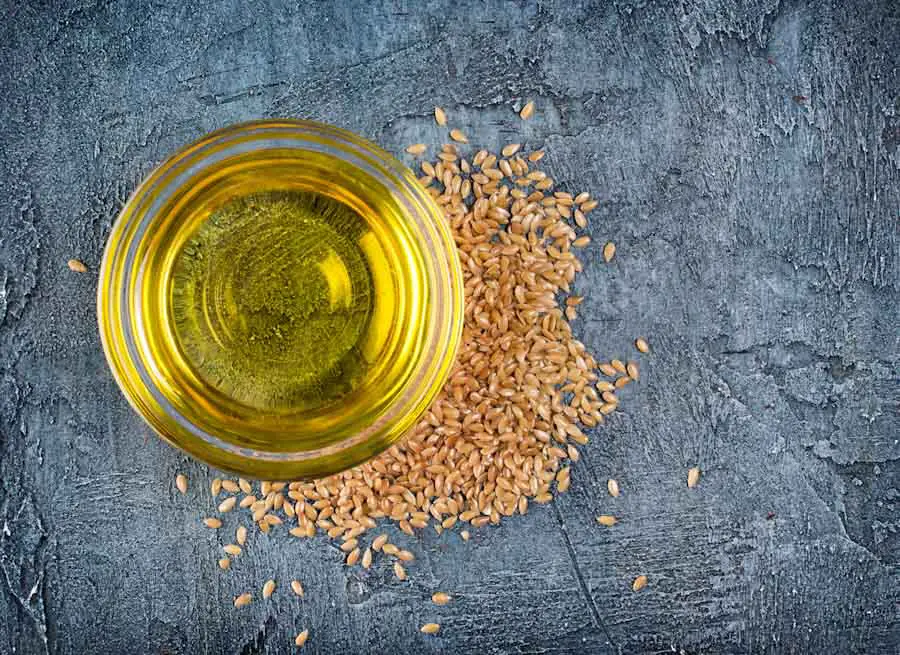
Use a naturally-derived oil such as mineral oil, boiled linseed oil, or vegetable oil, and wipe down the metal and wood surfaces of the tools. This will prevent rusting, keep wood from cracking, and protect the tools when they’re not being used.
Store your pruning tools in a location that stays relatively cool and dry. They will last longer if they aren’t exposed to extreme temperatures or moisture.

